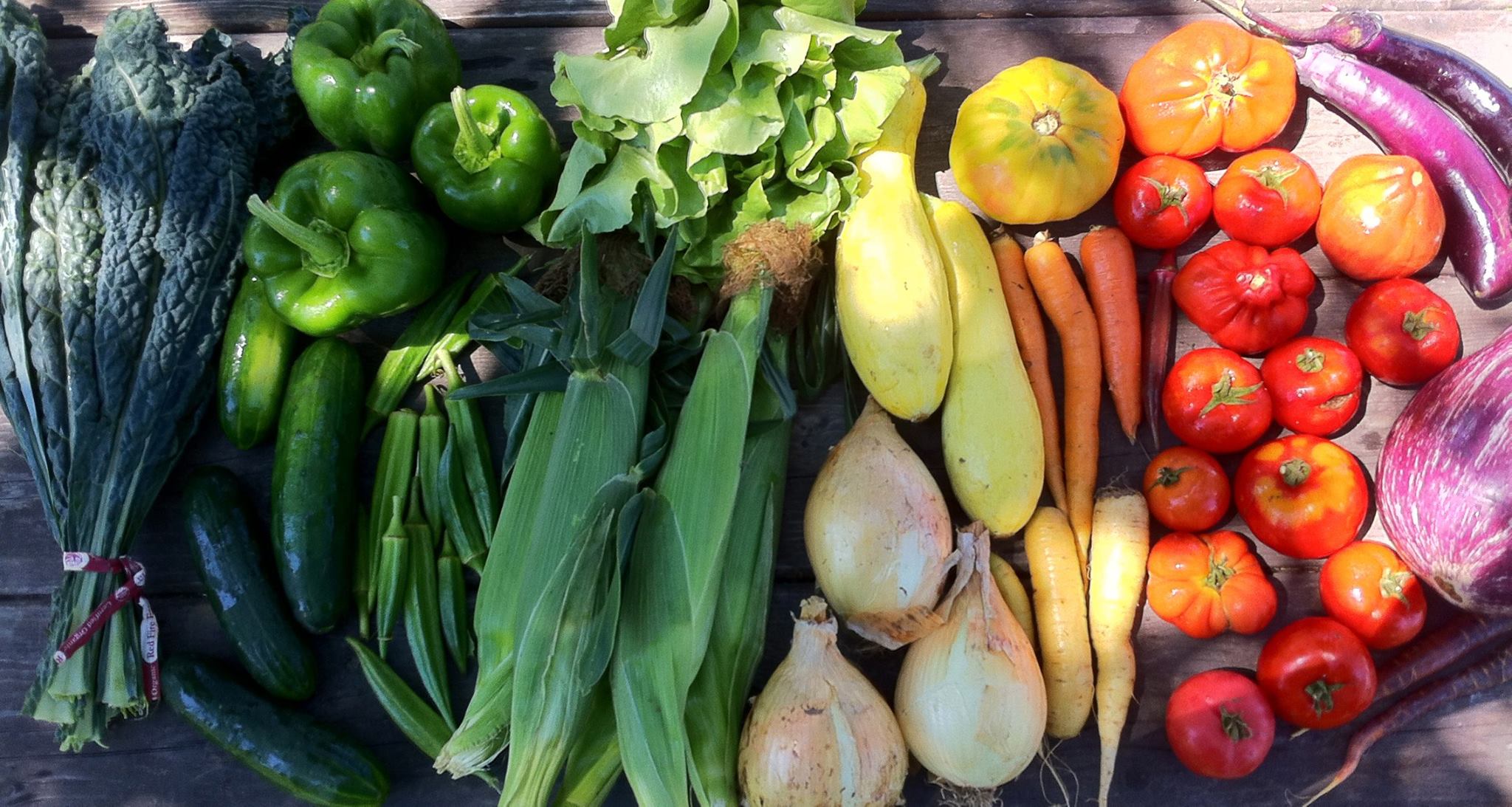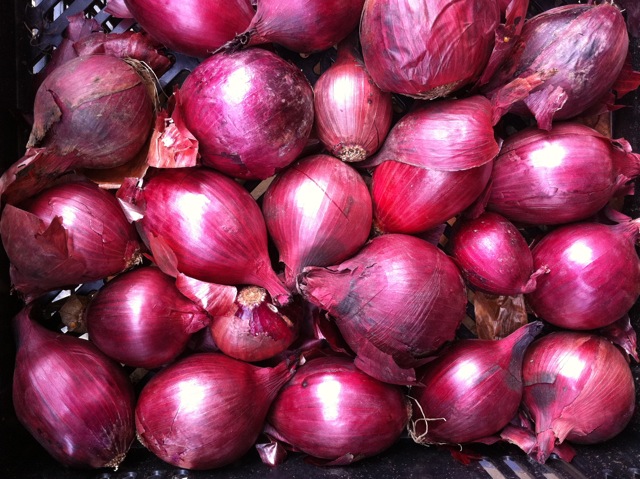When you come home from the market or CSA, you may have a big load of the season’s bounty on your hands. With such a variety of crops, it’s typically not best to open up the bottom drawer of the fridge and let everything get cozy together. In this article, we aim to give some tips for quickly organizing longer, more vibrant lives for your produce. Just a little more time/thought upfront, and you can get days more life.
If conditions are sound, vegetables will surprise you with their last-ability. For example, carrots will store for 3-5 months or more in the right cold, humid climate.
General Tips
- Perishability – Use the most perishable things first, and the hardier stuff later.
- Dream On. Look at your goods and dream up ways to use them when you get them. Something strange? Look it up on the internet for recipes and use that one early on, to prevent it sitting for a long while…
- Smoothies Rule. Try vegetables in smoothies or juices – very easy to make and drink!
- Stock it Up! – Make soup stock with your vegetable trimmings and anything you don’t think you’ll get to using. Cover trimmings with water and simmer covered for hours, then strain and store in fridge or freezer. Look up nice herbs to add. I like bay leaf and thyme.
Refrigeration is Your Friend
Here at the farm we have 3 large geothermal coolers and a root cellar to store our produce post-harvest. Cooling dramatically slows respiration and break-down processes in produce. Most of your produce would love to be refrigerated.
We make sure to lay thick sheets of plastic over all of the cooler-kept vegetables like salad greens and roots to keep them from drying out from the cool winds. Your refrigerator has cool winds too. Good for getting things cool, but protect your veggies from the wilting and drying effects.
When packing away your vegetables remember these tips:
- Bag it Up. Never store produce directly in the refrigerator. Keep items like greens, cucumbers, beets, broccoli, all roots, peppers, even corn*, loosely wrapped in a plastic bag.
*Keep corn wrapped in its protective husk.
- Bunched items. Cut the edible greens from crops like beets, radishes, carrots, and kohlrabi, before storing. The greens will drain moisture from the roots if left attached.
- Remove rubber bands, twisty ties, and other fasteners from vegetables for better circulation.
- Keep fruits and vegetables separate. Apples, apricots, avocados, ripening bananas, blueberries, cantaloupe, citrus fruit (not grapefruit), cranberries, figs, guavas, grapes, green onions, honeydew, ripe kiwi fruit, mangoes, melons, mushrooms, nectarines, okra, papayas, passion fruit, peaches, pears, peppers, persimmons, pineapple, plantains, plums, prunes, quinces, tomatoes and watermelon all release ethylene gas which will cause your remaining produce to spoil and change in flavor in proximity, especially sensitive greens. Try one of those ethylene “eggs” and report back to us.
- Try not to wash or chop vegetables before storing. The extra water will create conditions that are too damp and not ideal for crisp, tasty vegetables. If washing before storing, make sure to dry produce as well as possible and store in the company of a dry paper towel.
- On the other hand, Prep for Easy Use. Wash your lettuce leaves for salad and spin them nice and dry when you receive them, it will make it easy and quick later, and you’re more likely to make the salads! Same for other things you want to use soon washed.
- Wilted from rough travels? If your greens or other items had a rough ride home in a warm car, say, or a 90 degree day at the CSA, you can perk them up with a soak in a bowl of cold water before drying and putting them away.
Don’t Refrigerate These
Some crops, such as basil and tomatoes, need to be kept out of the refrigerator to maintain
optimum freshness. Basil leaves will quickly turn shriveled and brown if stored bare in the refrigerator. The best way to store a bunch of basil is on the countertop in a container of water like
flowers. You can also cover the basil “bouquet” loosely with a plastic bag to contain moisture. Tomatoes lose flavor and texture when chilled, so only refrigerate if you want to stop them from imminent death.
Sweet potatoes also are a tropical tuber and they get chilling injury if stored below 50 degrees, so keep them in a paper bag or basket.
Winter Squash – also gets chilling injury if stored below 50 degrees. Around 55 degrees is ideal. Though a kitchen will do just fine as long as you use it in a few weeks.
Okay for Room Temperature Storage
Freezing Makes for a Delicious Winter
Vegetable season in New England is short. But freezing some of your CSA bounty will let you taste summer when sunlight is fleeting and vegetables are from far away. Many items like tomatoes, green beans, broccoli, peppers, greens, zucchini, and the like, can all be stored in the freezer. Everything can be frozen direct, but some things will have longer, better freezer life if blanched.
For example, extra kale can be frozen and easily added to soups in the winter, try blanching the kale (or spinach or chard or basil etc.). Remove the bottom of the stems, wash the greens, and then follow the blanching steps below.
Blanching is a method to deactivate enzymes that reduce the storage life of frozen produce. Steam or boil produce in water for 2-3 minutes (time varies by produce, do a web search for how long to blanch your item). Then quickly plunge produce into cold water (ice in water is good) to prevent over-cooking (let soak for same amount of time you blanched to cool), and then drain and pat dry, bag in freezer bags, and label.
Save your blanching water for soups! I blanched snow peas and the water tasted like peas. Yum.
To blanch or not?
From what I can tell, blanching preserves the vitamins and nutrients in frozen vegetables, and color and texture. Blanching also kills some bacteria. Without blanching you will lose some nutritional value, not sure how much. Blanching also causes some nutritional loss itself (thus use your water as stock for soups!). You can freeze everything without blanching. Some fruits and vegetables have high enough acid that they don’t need to be blanched for nutritional preservation. Blanching takes time, so if you have no time, then just freeze direct and use earlier.
Blanching times and methods at the National Center for Home Food Preservation.
Cook more corn-on-the-cob than you can eat one night? It’s blanched already 🙂 Cut the corn off the cob and freeze it!
Some things you can freeze straight up…
- Tomatoes can be frozen as is, whole. Their skin will peel off when thawed. Core or chop if desired.
- Peppers can be cut into large pieces and frozen directly.
- Onions can be frozen directly.
- Freezing herbs in water in ice-cube trays, chopped leaves or pureed, makes cubes that are perfect for adding to soups. You can also freeze them loose in a bag and take ’em out to chop up later.
- Berries are great to freeze because they make deliciously thick smoothies! Pare them first to remove inedible pieces like stems and pits. Freeze on trays, then transfer to bags, or freeze in serving-size bags.
Most importantly, make sure you freeze your produce as soon as possible while it is lively.
Keeping Your Mushrooms Fresh…
- Store your mushrooms in a paper bag in the fridge. The paper allows the mushrooms to breath slightly without dehydrating quickly.
- Avoid storing mushrooms in plastic bags! Plastic restricts the mushroom’s ability to breathe, causing accelerated molding.
- If you don’t have time to use your mushrooms, or simply forget about them, you can rehydrate your mushrooms by placing them in warm water for 20 minutes. After they’re rehydrated you can add them to soups or sautés! After rehydrating your mushrooms, you can use the water you used for rehydrating to add a mushroom-like flavor to stock or grains like rice.
Other sources:
Quality Control in Frozen Vegetables – overall article about commercial scale freezing considerations.
Other Ways to Preserve
Jamming – check out our blog post
Drying Herbs – blog post with herb ID photos
How to Store Winter Vegetables – tips for long-keeping and root cellaring
We don’t have a post on it, but you can dehydrate things too! Lactofermentation is another great way to preserve things for longer.
If you have more tips from your experience, please share them here!
~Thanks for reading!
PDF of this post to print, includes edits and comments through 8-4-2013.





